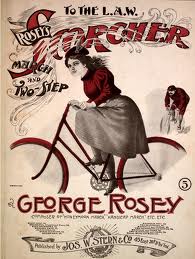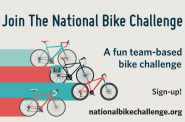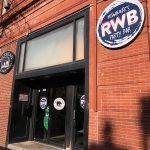Scofflaws Defend Themselves
Bicyclists and motorists who break the laws defend themselves. Are they right?

Proud to be a Scorcher and a Scofflaw
A couple days ago I wrote a follow-up to the Bike Fed’s Lobby Day efforts in which I discussed how we need to dispel the myth that people who ride bicycles break the law more frequently than people who drive motor vehicles. My primary argument was that people tend to break the laws they know they can get away with, whether in cars, on bikes or on foot. I also pointed out that that based on the facts from traffic studies, people actually tend to be more law abiding when riding bicycles than when driving cars, but we have a perception problem that the opposite is true. I then argued that everyone would be safer if all road users would obey all traffic laws all the time.
- Stop signs and traffic signals are generally installed without consideration of bicycles, so it is safer to disobey them
- It is safer to drive with the flow of traffic than the speed limit
I pulled a few of the more thoughtfully written arguments and pasted them below. The first pull quote came from an email and was the most thoughtfully written of the bunch. (Note the names have been changed to protect the guilty)
“Dave:
I just read your piece on cyclist “scofflaws”, and as a long-time, avid recreational and commuting cyclist, I have to respectfully disagree with you. When I break the law — by treating stop signs as yield signs, and red lights as stop signs — I make myself safer by limiting the amount of time I am in the most vulnerable position I am likely to face as a cyclist, namely at a standstill with moving traffic around me.
As a cyclist (and as a driver), I treat right-of-way laws as sacred, and will never violate them. If I come to a stop sign and another car is approaching, then I stop and yield (if the driver has the right-of-way; if I have the right-of-way, I take it). It is only when other cars are not present that I break the laws. Even at a red light, if there is no cross traffic and I can safely dart across (or jump the changing green), I will do so, since the cars behind me are a largest source of danger to me, either turning right across me or veering into me when they begin to accelerate.
I believe your piece would have had more power had you taken a position with more nuance — that sometimes traffic laws that cyclists are expected to follow actually make them less safe — and focused instead on the importance of being good citizens of the road, by obeying right-of-way (for both drivers and pedestrians).
Finally, as a driver, I must also take exception to your saying that drivers should drive the speed limit (or slower). Doing so is often DANGEROUS, as it causes tailgating and reckless passing. Driving along with the “flow of traffic” — neither faster nor slower than the vast majority of other drivers — is actually the safest approach (with the possible exception of places like school zones).
Thanks for your time and attention. I hope you won’t be too angered or disappointed that your plea fell on deaf ears with me, but I am a proud scofflaw — at least in terms of the definition of the term, as one who violates the letter of the law. I will, however, continue to obey the intent of those laws by following right-of-way and imploring other cyclists to do the same.
Respectfully,” – JM
“Although I don’t wear spandex, I break laws every day. Lots of them. Walking, biking, driving. We need to get over the idea that traffic laws lead to safety. Plus, time is on the side of bicyclists as there will be more of them in the future. As always, I will use the opportunity to give a shout out to the Idaho Stop.” -PC
“I have the opposite attitude. We have no dedicated infrastructure, nor protective laws, therefore the law does not apply to us.” -BR
I appreciate the respectful dialogue and understand that these conscientious objectors are making thoughtful personal decisions, but based on my dozen years studying traffic safety, designing bikeways and teaching bicycle safety, I have to disagree with the premises on which their arguments are founded.
In his email, JM argues that the safest course of action when bicycling is to limit exposure to motor vehicles at intersections, so he treats stop signs as yield signs and signals as stop signs. All the crash studies I have seen indicate that while it is true that most crashes happen at intersections, they key to avoiding crashes at intersections is to obey the traffic control devices at intersections such as yield signs, stop signs, traffic signals or the rules of right of way at uncontrolled intersections. For instance, a ten-year study of bicycle crashes recently published by the Minneapolis Dept. of Transportation found:
- Most crashes are occurring at intersections along major arterials
- Motorists are not seeing or yielding to bicyclists
- Bicyclists are not riding in a predictable manner
A similar crash-typing study done by the Wisconsin Dept. of Transportation found similar results here. Until someone shows me a study that disputes these results, as a League Certified Instructor for teaching bicycle safety, I will continue to advise people to stop for stop signs and wait for green lights at traffic signals. I do agree that we now have lots of un-warranted stop signs and traffic signals that were installed in a misguided attempt to stop people from speeding or to force people to yield to pedestrians at crosswalks. But rather than pass a version of the Idaho Stop Law so people on bikes are not required to stop for unwarranted signs and signals, I would prefer to slow cars with more enforcement and traffic calming when necessary. Rather than adapt our laws to ineffective traffic engineering, let’s design roads so they are safe for all users and actually enforce speed limits, rather than enforce 10mph over the limit.
To the second point in JM’s email in which he suggests it is safer to drive with the flow of traffic than to drive the speed limit, I would argue that the flow of traffic would be the speed limit (or slower) if we enforced the laws we have and designed streets in context of safety for all road users. This is the concept behind modern traffic calming and things like Bicycle Boulevards and Woonerfs. I also disagree that it is safer to speed except in school zones. The concept that it is safer to drive with the flow of traffic than the posted speed limit is biased to reduce crashes between motor vehicles, not to protect more vulnerable road users.
In a crash between a person walking or biking and a motor vehicle, even a reduction in speed of 5mph can mean the difference between life and death. A study done by the AAA showed the average risk of death for a pedestrian reaches 10% at an impact speed of 23 mph, 25% at 32 mph, 50% at 42 mph, 75% at 50 mph, and 90% at 58 mph. In Zurich, the urban area speed limit was lowered from 60 to 50 km/h [37 to 31 mph] in 1980 in response to a reduction in the open road speed limit. In the year after the change there was a reduction of 16 percent in pedestrian accidents and a reduction of 25 percent in pedestrian fatalities (Walz et al, 1983). The authors of this study observed that, because of those who “don’t believe in the influence of driving speed on impact speed” or who “just don’t care at all”, “it must be proven in every country that the laws of Isaac Newton are true”.) [page 41]
This study found similar relationship between speed and fatal crashes involving vulnerable road users:
| |
|
|
| |
|
|
| |
|
|
| |
|
|
[Source 1: Killing Speed and Saving Lives, UK Dept. of Transportation, London, England. See also Limpert, Rudolph. Motor Vehicle Accident Reconstruction and Cause Analysis. Fourth Edition. Charlottesville, VA. The Michie Company, 1994, p. 663.]
The one place where it probably is safer to drive with the flow of speeding traffic rather than the speed limit is on freeways where 99% of cars are traveling 5-10 mph over the posted limit and there are very few, if any, vulnerable road users. Of course there are still law enforcement officers, highway workers, and people who have had break downs, but those numbers are small compared to the volume of traffic on the road. Still, that argument is like saying referees should stop penalizing hockey players for fighting because everyone wants to do it and there are no innocent players. As I mentioned above, I prefer we enforce the rules we have and change those we don’t like.
If the vast majority of people want to drive 75mph on the interstate highway, let’s change the speed limit rather than pay to have signs put up that everyone knows they can ignore and then pay troopers to enforce an unwritten law.
As a paid advocate for bicycling and as a bicycle safety professional, I will continue to advocate for streets that are designed to move people and goods, not motor vehicles. I will also continue to make the case that all road users would be safer if we all obeyed all the laws all the time.
But then I have been tilting at windmills for most of my life and some habits are hard to break.
This story was originally published by the Bicycle Federation of Wisconsin.
Bike Czar
-
Join a Bike Ride Under the Polish Moon
 Jun 1st, 2018 by Dave Schlabowske
Jun 1st, 2018 by Dave Schlabowske
-
9 Reasons to Join National Bike Challenge
 May 4th, 2018 by Dave Schlabowske
May 4th, 2018 by Dave Schlabowske
-
Biking Through the Mindoro Cut
 Apr 27th, 2018 by Dave Schlabowske
Apr 27th, 2018 by Dave Schlabowske






















Nothing wrong with bikers treating stop signs as yield signs, and red lights as stop signs.
I have a hard time understanding your point of view.
in this post you state: “As a paid advocate for bicycling and as a bicycle safety professional, I will continue to advocate for streets that are designed to move people and goods, not motor vehicles. I will also continue to make the case that all road users would be safer if we all obeyed all the laws all the time.”
Yet as the official voice of Bike Fed, you post (regarding bike messengers): “I ignore the laws bike messengers break because they provide daily inspiration for just how fast and efficient a mode of transport the bicycle can be. I admire bike messengers because they have managed to blend punk rock and professionalism. I call a number of bike messengers friends because they are genuinely nice people with whom I have a lot in common.”
The two posts seem at odds with each other.
Perhaps I should not have used the word “ignore.” I don’t really ignore that couriers break some laws, but I understand why they do so, just as I understand why people in cars drive over the posted limit and fail to yield to people trying to cross the street at a crosswalk. You have a valid question, but I think people can be at odds with each other on some issues and still admire each other for other reasons. In a civil society (becoming harder to find), that happens all the time.
As an advocate at the Bike Fed, I must work in the real world where there people in all modes (walking, biking, motoring) break traffic laws. With the resources we have, we do all I can to teach and encourage people to ride bicycles safely and legally. Every year we teach about 2,500 people in our adult cycling classes how to ride legally and safely. We teach about the same number of children in our safe routes to school classes. We publish half a dozen brochures that show people how to ride a bicycle legally and safely and how to drive a motor vehicle legally and safely next to bicycles.
We also have a statewide media campaign to encourage people to bike and drive safely and legally. We have regional staff across the state who attend all sorts of events, from fairs to bike events, to distribute this information in person and in print. Finally, we work with the state drivers education instructors to try to get this information included in their classes.
So, on a professional advocate level, I think we are consistent in our message and doing a lot on a very limited budget. So while we are working for greater compliance, I can still be inspired when I see a courier delivering 200 T-shirts or 50 cupcakes on a cargo bike. I can still wonder at the efficiency of couriers who can pick up and deliver an important legal document across town in about the same time that it would take to walk from the law firm office to their parking garage.
The bike messengers who are my friends know I stop for red lights. I know they run them most times. They still appreciate what I do as an advocate and I still appreciate what they do for the city.